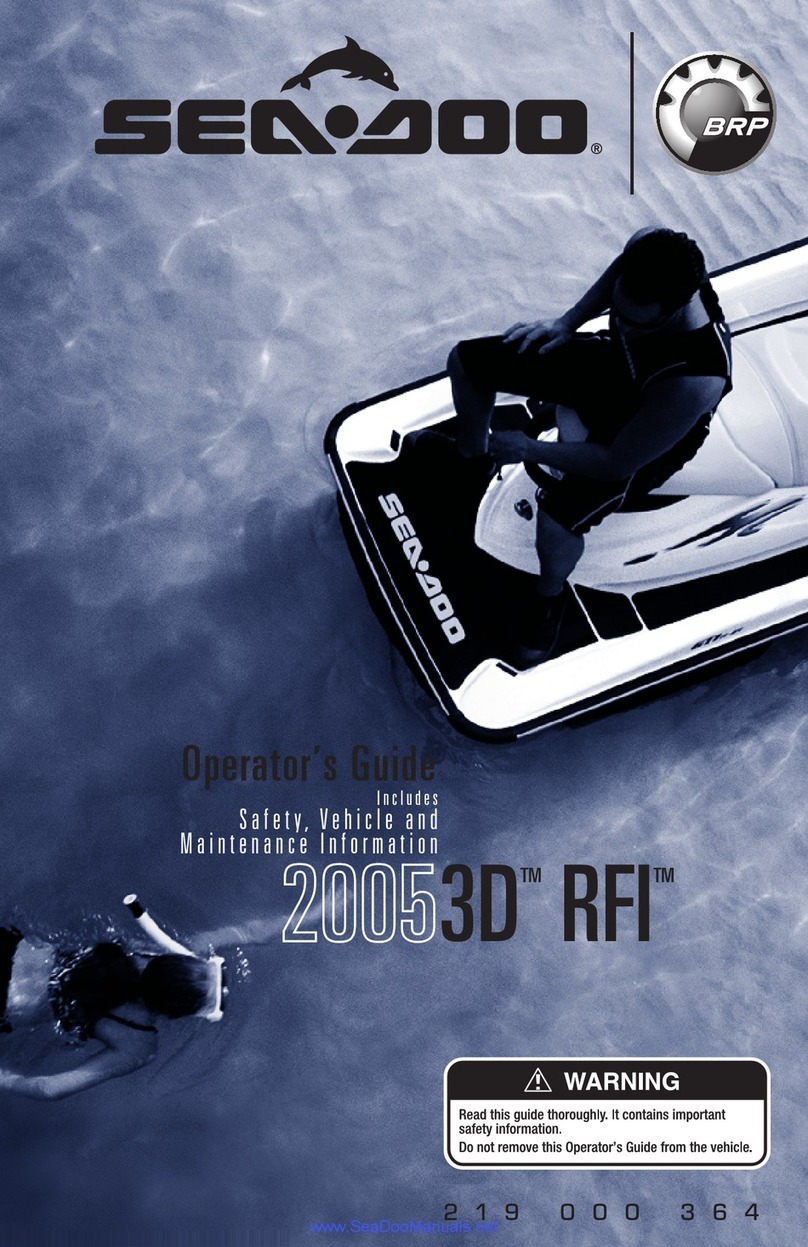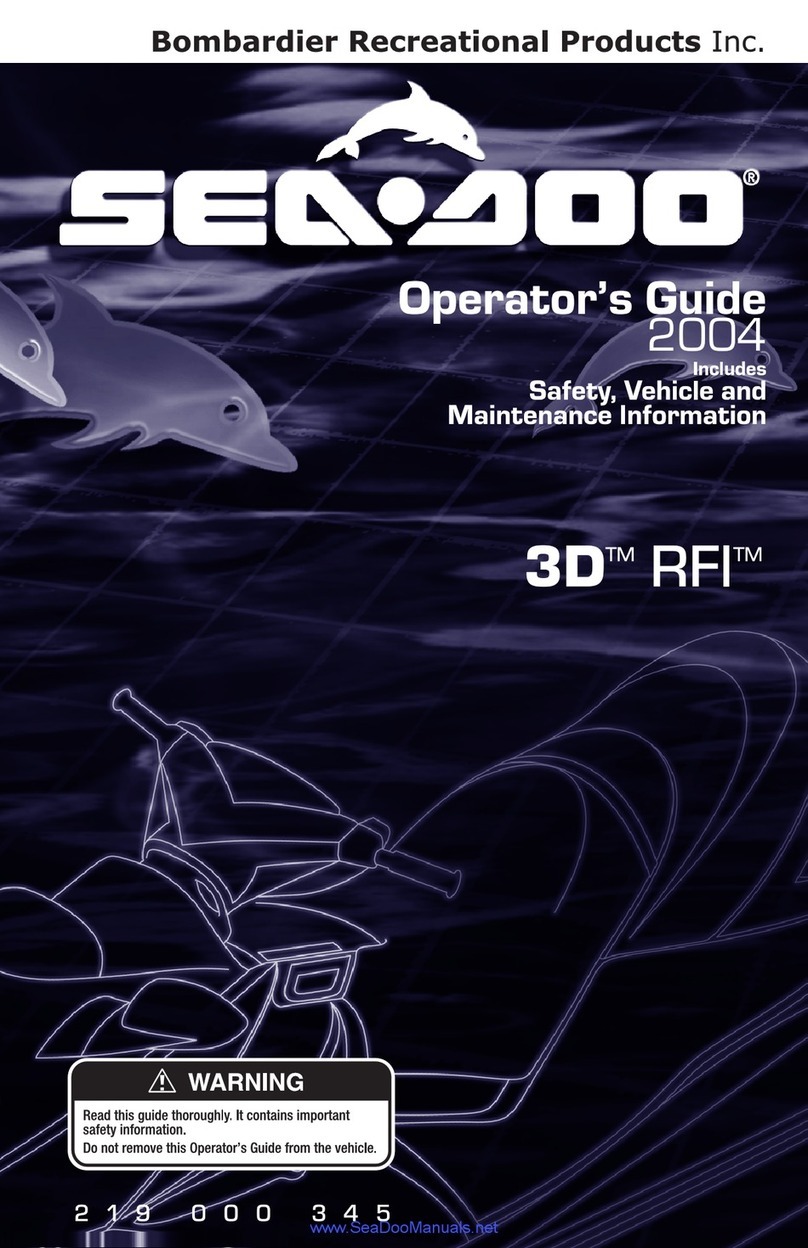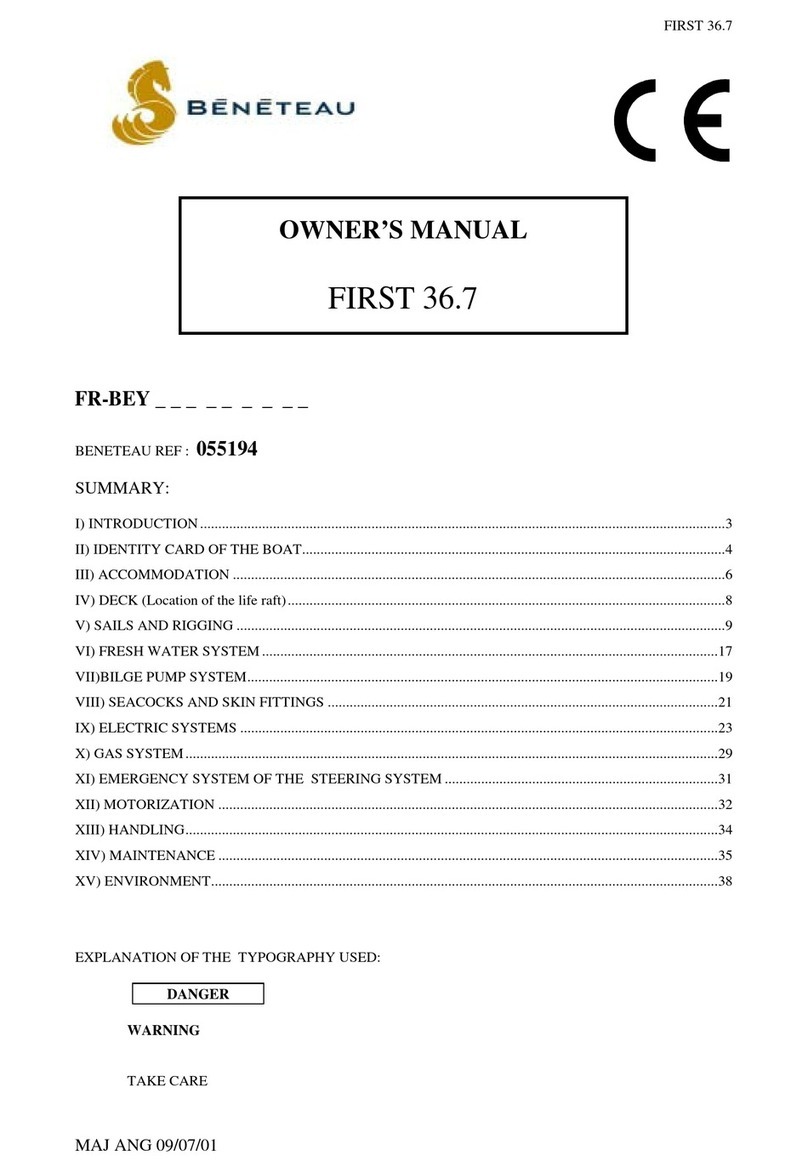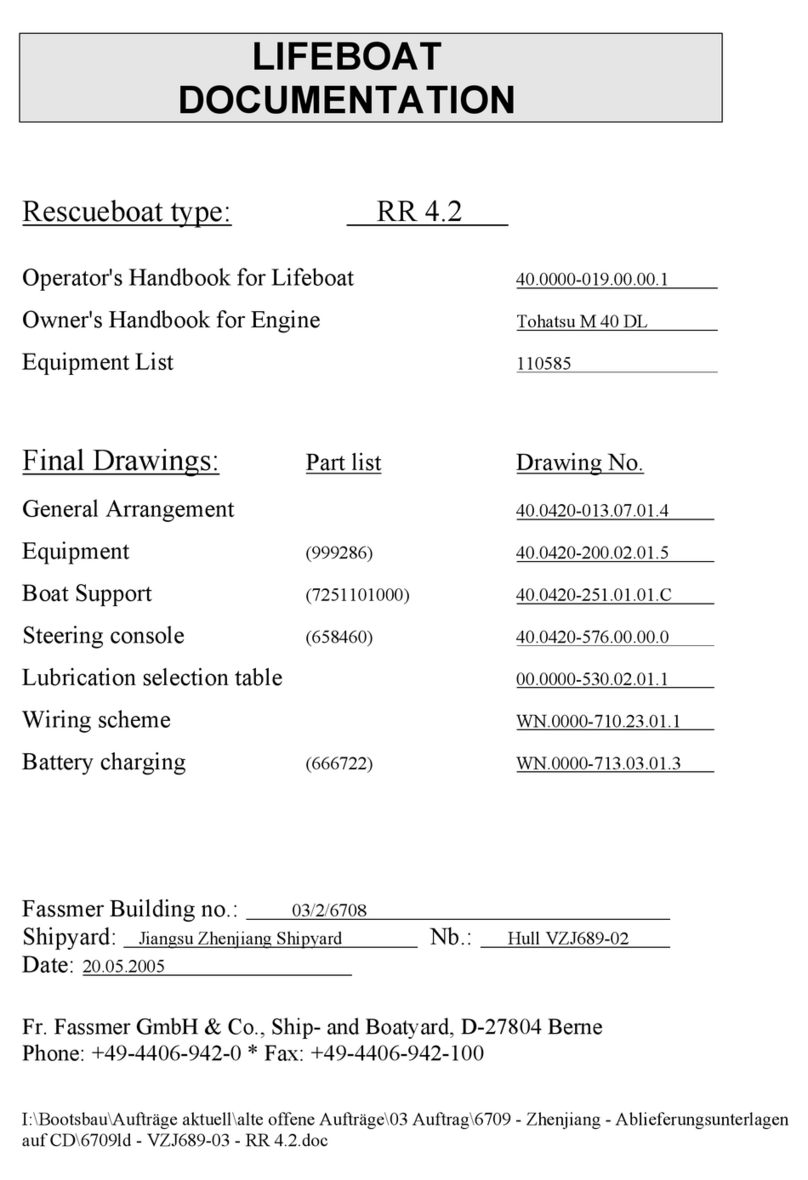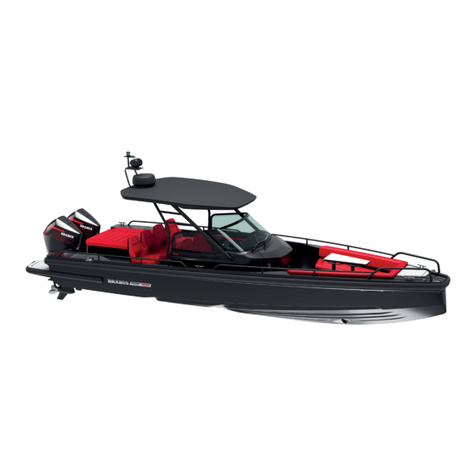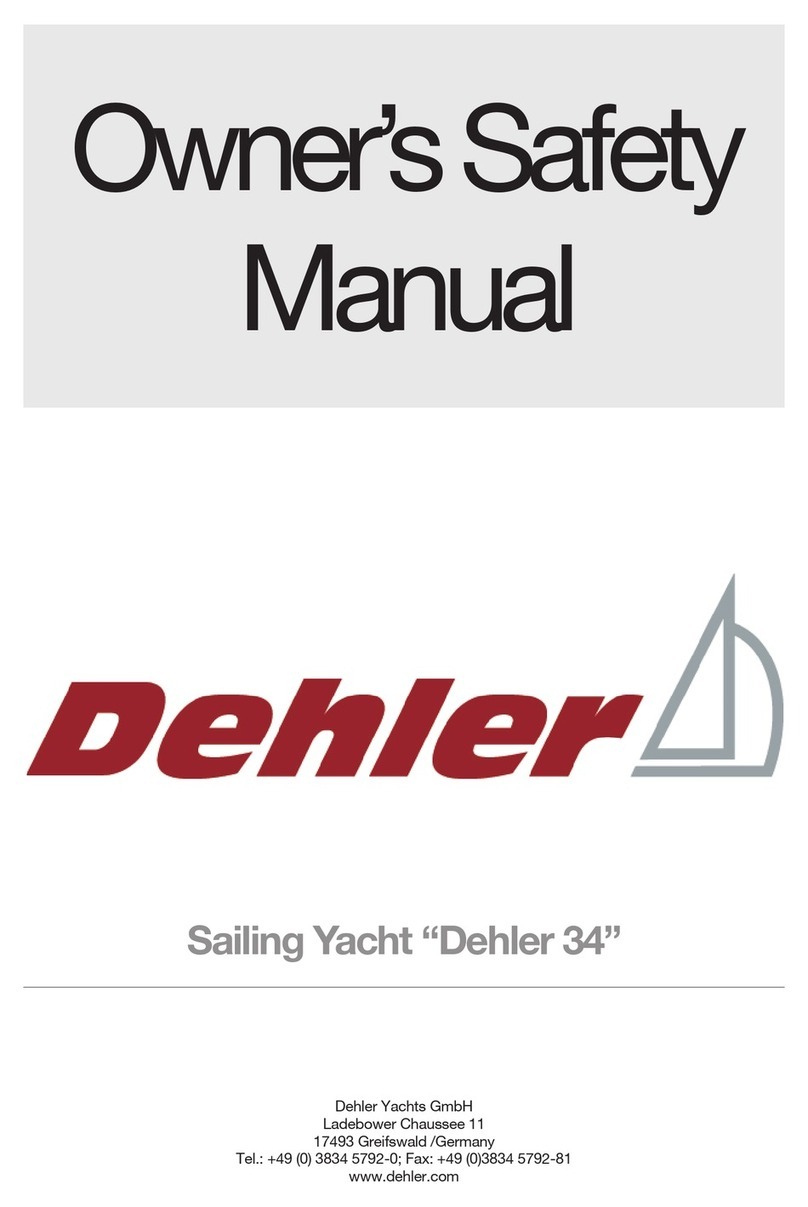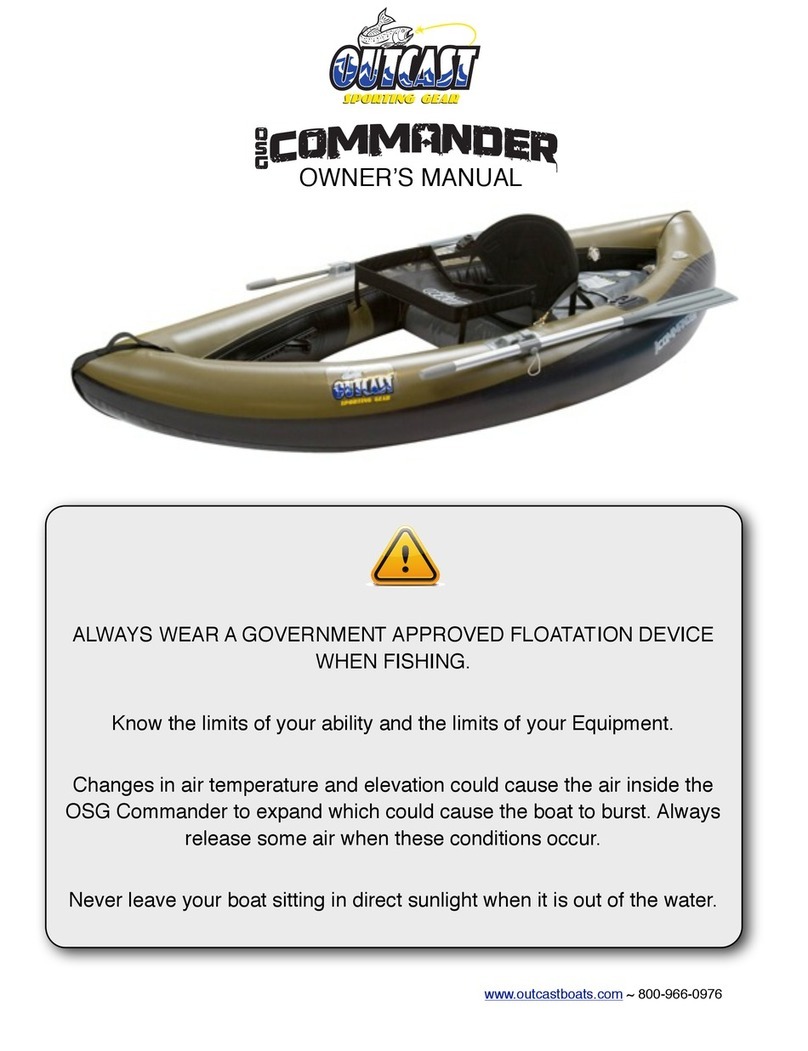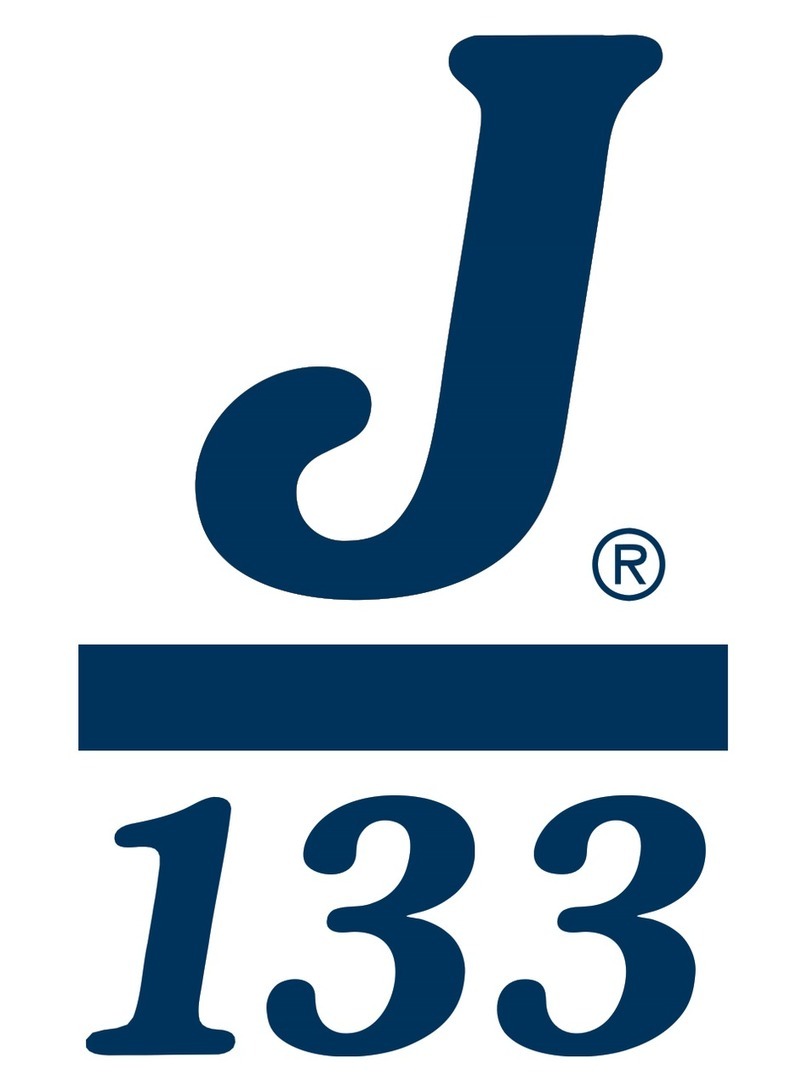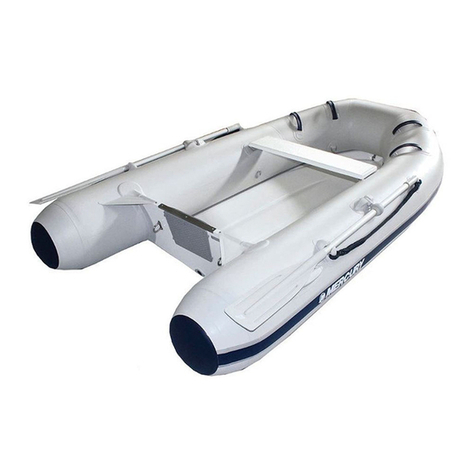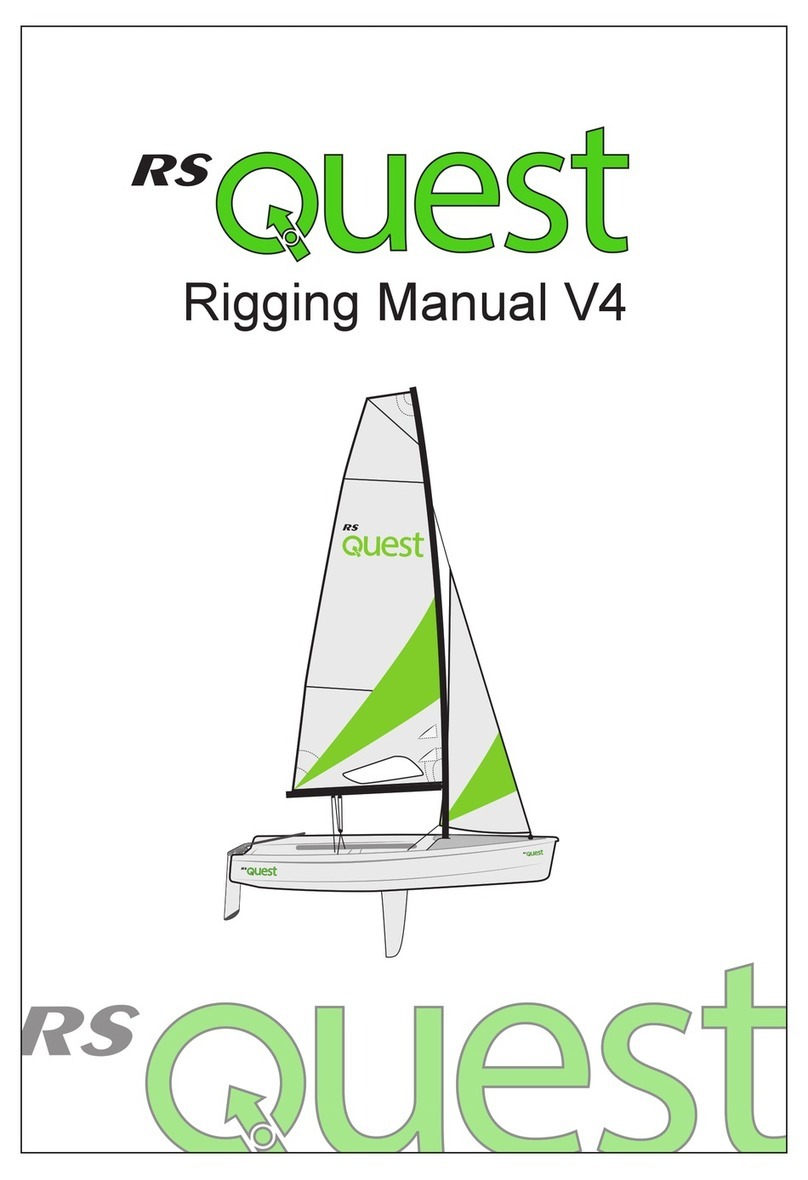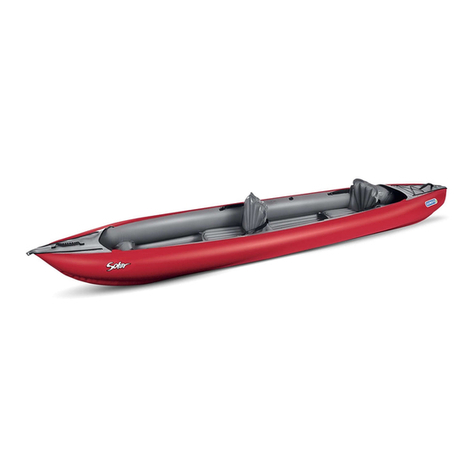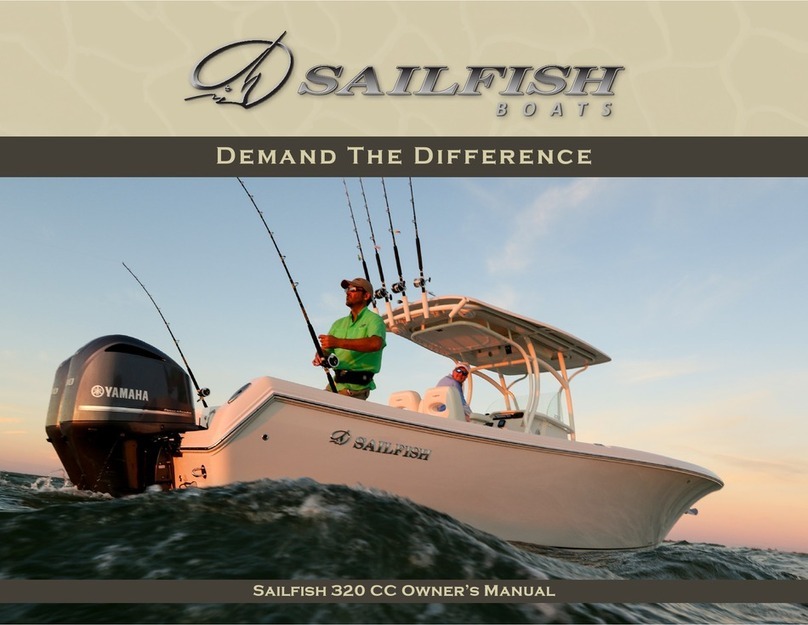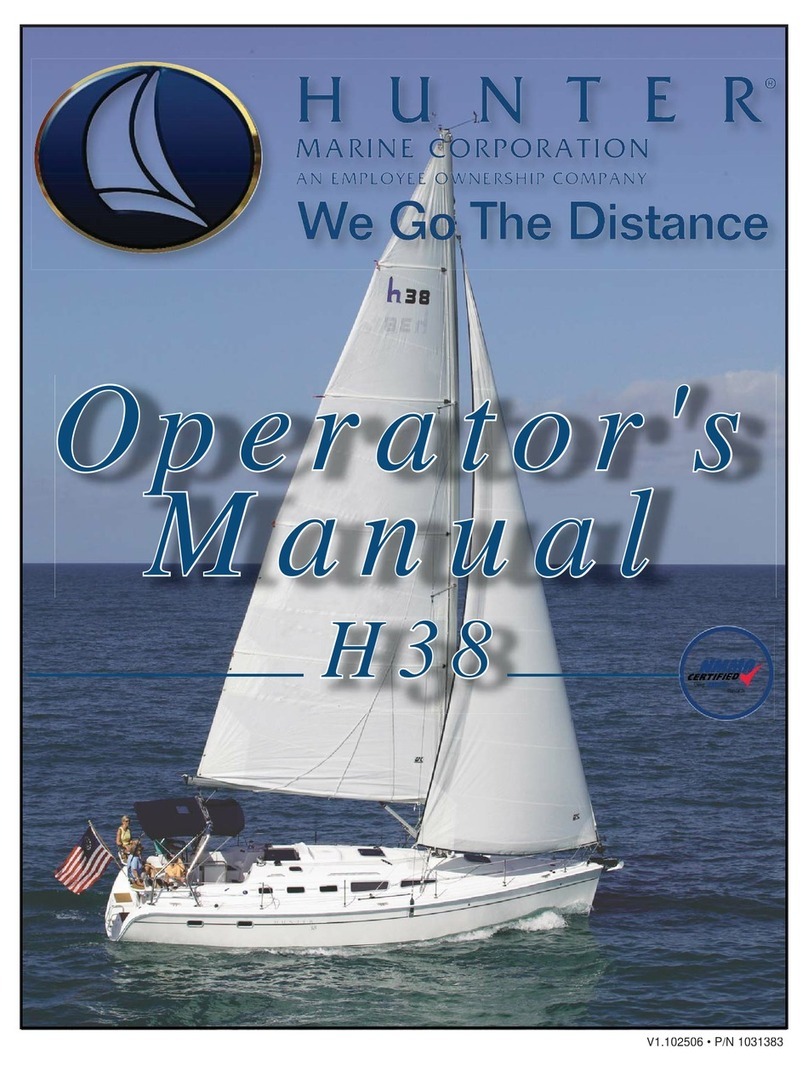Sea-doo SAR 2018 Series Manual

2018
OPERATOR’S
GUIDE
2016 (SEARCH AND RESCUE)
®
SEA-DOO SAR
Original Instructions
2018
Original Instructions
219 001 939
SEA-DOO SAR
SEARCH AND RESCUE
SERIES
FAIT AU / MADE IN CANADA U/M:P.C
219 001 939
OPERATOR’S GUIDE, SEA-DOO SAR SERIES / ENGLISH
GUIDE DU CONDUCTEUR, SÉRIE SEA-DOO SAR / ANGLAIS
®™ AND THE BRP LOGO ARE TRADEMARKS OF BOMBARDIER RECREATIONAL PRODUCTS INC. OR ITS AFFILIATES.
©2017 BOMBARDIER RECREATIONAL PRODUCTS INC. ALL RIGHTS RESERVED. PRINTED IN CANADA.

WARNING
Disregarding any of the safety precautions and instructions contained
in this Operator’s Guide and on-product safety labels could cause injury
including the possibility of death!
CALIFORNIA PROPOSITION 65 WARNING
WARNING
This watercraft contains or emits chemicals known to the state of California
to cause cancer and birth defects or other reproductive harm.
In Canada, products are distributed by Bombardier Recreational Products Inc.
(BRP).
In USA, products are distributed by BRP US Inc.
This is a non-exhaustive list of trademarks that are the property of Bombardier
Recreational Products Inc. or its affiliates:
O.T.A.S.TM VTSTM
iTCTM Rotax®
iBRTM Sea-Doo®
iControlTM 4-TECTM
T.O.P.S.TM XPSTM
219001939 en SG
®™ and the BRP logo are trademarks of Bombardier Recreational Products Inc. or its affiliates.
©2018 Bombardier Recreational Products Inc. and BRP US Inc. All rights reserved.

FOREWORD
Deutsch
Dieses Handbuch ist möglicherweise in Ihrer Landessprache
verfügbar. Bitte wenden Sie sich an Ihren Händler oder besuchen Sie:
www.operatorsguides.brp.com
English This guide may be available in your language. Check with your dealer or
go to: www.operatorsguides.brp.com
Español Es posible que este manual esté disponible en su idioma. Consulte a su
distribuidor o visite: www.operatorsguides.brp.com
Français Ce guide peut être disponible dans votre langue. Vérifier avec votre
concessionnaire ou aller à: www.operatorsguides.brp.com
日本語
このガイドは、言語によって翻訳版が用意されています。.
ディーラーに問い合わせるか、次のアドレスでご確認ください:
www.operatorsguides.brp.com
Nederlands Deze handleiding kan beschikbaar zijn in uw taal. Vraag het aan uw dealer
of ga naar: www.operatorsguides.brp.com
Norsk Denne boken kan finnes tilgjengelig på ditt eget språk. Kontakt din
forhandler eller gå til: www.operatorsguides.brp.com
Português Este manual pode estar disponível emseu idioma. Fale comsua
concessionária ou visite o site: www.operatorsguides.brp.com
SuomiKäyttöohjekirja voi olla saatavissa omalla kielelläsi. Tarkista jälleenmyyjältä
tai käy osoitteessa: www.operatorsguides.brp.com
Svenska Denna bok kan finnas tillgänglig på ditt språk. Kontakta din återförsäljare
eller gå till: www.operatorsguides.brp.com
本手册可能有您的语种的翻译版本。请向经销商问询,或者登录
www.operatorsguides.brp.com
中文 查询。
Congratulations on your purchase of a
new Sea-Doo®SAR (Search and Res-
cue) personal watercraft (PWC). It is
backed by the BRP warranty and a net-
work of authorized Sea-Doo personal
watercraft dealers ready to provide the
parts, service or accessories you may
require.
Your dealer is committed to your sat-
isfaction. He has taken training to per-
form the initial setup and inspection of
your watercraft as well as completed
the final adjustment before you took
possession. If you need more com-
plete servicing information, please ask
your dealer.
At delivery, you were also informed of
the warranty coverage and signed the
PREDELIVERY CHECK LIST
to ensure
your new watercraft was prepared to
your entire satisfaction.
Know Before you Go
This watercraft is intended for profes-
sional rescuers with adequate training
and equipment. The users must have
followed a safe boating course and ad-
vance training for search and rescue
operations.
_______________ 1

FOREWORD
To learn how to reduce the risk of be-
ing injured or killed, read the following
sections before you operate the water-
craft:
–
SAFETY INFORMATION
–
WATERCRAFT INFORMATION
.
Read and understand all safety labels
on this watercraft.
Failure to follow the warnings con-
tained in this Operator's Guide can
result in serious injury or death.
WARNING
Get familiar with this PWC; it may
exceed the performance of other
PWCs you have ridden.
Safety Messages
This Operator’s Guide utilizes the fol-
lowing symbols and words to empha-
size particular information:
The safety alert symbol indicates
a potential injury hazard.
WARNING
Indicates a potential hazard which,
if not avoided, could result in seri-
ous injury or death.
CAUTION Indicates a poten-
tially hazardous situation which, if
not avoided, could result in minor or
moderate injury.
NOTICE Indicates an instruction
which, if not followed, could se-
verely damage watercraft compo-
nents or other property.
About this Operator's
Guide
This Operator's Guide has been pre-
pared to acquaint the users with this
personal watercraft and its various
controls, maintenance and safe riding
instructions.
Keep this Operator's Guide in the wa-
tercraft as you can refer to it for oper-
ation, instructing others, maintenance
and troubleshooting.
Note that this guide is available in sev-
eral languages. In the event of any dis-
crepancy, the English version shall pre-
vail.
Ifyouwanttoviewand/orprintan
extra copy of this Operator's Guide,
simply visit the following website
www.operatorsguides.brp.com.
The information contained in this doc-
ument is correct at the time of publica-
tion. However, BRP maintains a pol-
icy of continuous improvement of its
products without imposing upon itself
any obligation to install them on prod-
ucts previously manufactured. Due
to late changes, some differences be-
tween the manufactured product and
the descriptions and/or specifications
in this guide may occur. BRP reserves
the right at any time to discontinue or
change specifications, designs, fea-
tures, models or equipment without
incurring any obligation upon itself.
Pictures shown throughout this guide
are for reference purpose only. Some
pictures may show equipment that are
not included.
2_______________

TABLE OF CONTENTS
FOREWORD .......................................................................... 1
KnowBeforeyouGo............................................................. 1
SafetyMessages................................................................. 2
AboutthisOperator'sGuide .................................................... 2
SAFETY INFORMATION
GENERAL PRECAUTIONS.......................................................... 8
AvoidCarbonMonoxidePoisoning............................................. 8
AvoidGasoline FiresandOtherHazards ....................................... 8
AvoidBurnsfromHotParts ..................................................... 8
AccessoriesandModifications ................................................. 8
SPECIAL SAFETY MESSAGES .................................................... 9
RemindersRegardingSafeOperation.......................................... 9
Hypothermia..................................................................... 12
Safe Boating Courses........................................................... 13
ACTIVETECHNOLOGIES (iCONTROL).......................................... 14
Introduction...................................................................... 14
iTC (intelligent Throttle Control) ................................................ 14
iBR (intelligentBrake and Reverse System) .................................. 15
SAFETY EQUIPMENT.............................................................. 17
Required SafetyEquipment.................................................... 17
PRACTICEEXERCISES............................................................. 20
Whereto PracticeExercises ................................................... 20
Practice Exercises .............................................................. 20
ImportantFactors Notto Neglect.............................................. 21
NAVIGATION RULES............................................................... 22
Operating Rules................................................................. 22
FUELING ............................................................................. 24
FuelingProcedure............................................................... 24
Fuel Requirements.............................................................. 25
TRAILERINGINFORMATION ..................................................... 26
IMPORTANTON-PRODUCTLABELS............................................ 27
Watercraft SafetyLabels ....................................................... 27
Product InformationLabels .................................................... 31
ComplianceLabels.............................................................. 32
PRE-RIDEINSPECTION ............................................................ 34
WhattoDoBeforeLaunching the Watercraft ................................ 34
WhattoDoAfterLaunchingtheWatercraft .................................. 36
WATERCRAFT INFORMATION
CONTROLS.......................................................................... 40
1) Handlebar ..................................................................... 40
_______________ 3

TABLE OF CONTENTS
CONTROLS (cont’d)
2)Engine START/STOPButton................................................. 40
3) Engine Cut-Off Switch ....................................................... 41
4)ThrottleLever................................................................. 41
5) iBR Lever (intelligent Brake and Reverse) .................................. 41
6)MODE/SET Buttons.......................................................... 42
7)UP/DOWNButtons .......................................................... 42
8)Cruise Button................................................................. 43
9)SportButton .................................................................. 43
10) ECOButton.................................................................. 43
INFORMATION CENTER(GAUGES)............................................. 44
Multifunction GaugeFeatures ................................................. 44
Multifunction Gauge Description .............................................. 45
Navigatingthe Multifunction Display.......................................... 50
Changing NumericalDisplay Indication ....................................... 53
ResettingNumericalDisplay Indication ....................................... 53
Multifunction GaugeSetup..................................................... 54
AnalogSpeedometerDescription ............................................. 54
AnalogTachometerDescription ............................................... 55
EQUIPMENT......................................................................... 56
1)Glove Box ..................................................................... 56
2)Front StorageCompartment ................................................ 56
3)Seat............................................................................ 57
4)PassengerHandhold......................................................... 58
5)BoardingPlatform ............................................................ 58
6)BoardingStep................................................................. 58
7)Eyelets ........................................................................ 59
8)Bilge Drain Plugs ............................................................. 60
9)RearMast..................................................................... 60
10) Navigation Lights ........................................................... 60
11) Inflatable Sponsons......................................................... 60
12) Ropes........................................................................ 61
13) RunningBoards............................................................. 61
14) Heavy-Duty FrontBumper ................................................. 61
15) FlipLine...................................................................... 61
BREAK-IN PERIOD.................................................................. 62
Operation During Break-In Period.............................................. 62
OPERATINGINSTRUCTIONS..................................................... 63
Boarding the Watercraft........................................................ 63
How to Start Engine............................................................. 65
How to Stop theEngine ........................................................ 66
How to Steer theWatercraft ................................................... 66
How to EngageNeutral......................................................... 67
How to EngageForward........................................................ 68
How to Engageand UseReverse.............................................. 68
How to Engageand UseBraking............................................... 69
How to UsetheVariableTrimSystem(VTS) .................................. 71
4_______________

TABLE OF CONTENTS
OPERATING INSTRUCTIONS (cont’d)
GeneralOperating Recommendations........................................ 74
OPERATINGMODES............................................................... 77
SportMode...................................................................... 77
Touring Mode.................................................................... 77
ECO Mode(FuelEconomyMode)............................................. 78
CruiseMode..................................................................... 79
Slow SpeedMode .............................................................. 81
SPECIAL PROCEDURES ........................................................... 84
Jet PumpWater IntakeandImpellerCleaning................................ 84
Capsized Watercraft ............................................................ 86
Submerged Watercraft ......................................................... 87
Water-FloodedEngine.......................................................... 87
Towing the Watercraft inWater................................................ 87
MAINTENANCE INFORMATION
MAINTENANCESCHEDULE...................................................... 90
MAINTENANCEPROCEDURES .................................................. 94
EngineCompartment........................................................... 94
EngineOil........................................................................ 94
EngineCoolant .................................................................. 96
IgnitionCoils..................................................................... 97
SparkPlugs ...................................................................... 98
ExhaustSystem andHeatExchanger......................................... 99
Ride PlateandWater IntakeGrate........................................... 100
SacrificialAnode............................................................... 101
Fuses........................................................................... 101
InflatableSponsons........................................................... 104
WATERCRAFT CARE ............................................................. 108
Post-OperationCare .......................................................... 108
Watercraft Cleaning........................................................... 108
Post-OperationInspection ................................................... 109
STORAGE ANDPRESEASON PREPARATION................................ 111
Storage......................................................................... 111
PreseasonPreparation ....................................................... 113
TECHNICAL INFORMATION
WATERCRAFT IDENTIFICATION ............................................... 116
Hull Identification Number ................................................... 116
EngineIdentificationNumber................................................ 116
ENGINE EMISSIONSINFORMATION.......................................... 117
Manufacturer's Responsibility ............................................... 117
Dealer's Responsibility ....................................................... 117
_______________ 5

TABLE OF CONTENTS
ENGINE EMISSIONS INFORMATION (cont’d)
Owner Responsibility ......................................................... 117
EPA Emission Regulations ................................................... 117
SPECIFICATIONS ................................................................. 118
TROUBLESHOOTING
TROUBLESHOOTINGGUIDELINES ........................................... 122
MONITORING SYSTEM ......................................................... 127
FaultCodes.................................................................... 127
FaultIndicatorsandMessage Display Information......................... 128
BeeperCode Information .................................................... 130
WARRANTY
BRP LIMITED WARRANTY – USA AND CANADA: 2018 SEA-DOO®PERSONAL
WATERCRAFT..................................................................... 132
US EPA EMISSION-RELATED WARRANTY................................... 136
CALIFORNIA AND NEW YORK EMISSION CONTROL WARRANTY
STATEMENT FOR MODEL YEAR 2018 SEA-DOO®PERSONAL
WATERCRAFT..................................................................... 139
BRP INTERNATIONAL LIMITED WARRANTY: 2018 SEA-DOO®PERSONAL
WATERCRAFT..................................................................... 143
BRP LIMITED WARRANTY FOR THE EUROPEAN ECONOMIC AREA,
THE COMMONWEALTH OF THE INDEPENDENT STATES, TURKEY: 2018
SEA-DOO®PERSONALWATERCRAFT........................................ 148
CUSTOMER INFORMATION
PRIVACYINFORMATION........................................................ 154
CONTACTUS...................................................................... 155
NorthAmerica................................................................. 155
Europe ......................................................................... 155
Oceania ........................................................................ 155
SouthAmerica................................................................. 155
Asia............................................................................. 155
CHANGE OFADDRESS/OWNERSHIP......................................... 156
6_______________

SAFETY
INFORMATION
________ SAFETY INFORMATION ________ 7

GENERAL PRECAUTIONS
Avoid Carbon Monoxide
Poisoning
All engine exhaust contains carbon
monoxide, a deadly gas. Breathing car-
bon monoxide can cause headaches,
dizziness, drowsiness, nausea, confu-
sion and eventually death.
Carbon monoxide is a colorless, odor-
less, tasteless gas that may be present
even if you do not see or smell any en-
gine exhaust. Deadly levels of carbon
monoxide can collect rapidly, and you
can quickly be overcome and unable
to save yourself. Also, deadly levels of
carbon monoxide can linger for hours
or days in enclosed or poorly ventilated
areas. If you experience any symp-
toms of carbon monoxide poisoning,
leave the area immediately, get fresh
air and seek medical treatment.
To prevent serious injury or death from
carbon monoxide:
– Never run the watercraft in poorly
ventilated or partially enclosed ar-
eas such as seawalls or other boats
in close proximity. Even if you try
to ventilate engine exhaust, carbon
monoxide can rapidly reach danger-
ous levels.
– Never run the watercraft outdoors
where engine exhaust can be drawn
into a building through openings
such as windows and doors.
– Never stand behind the watercraft
while the engine is running. A per-
son standing behind a running en-
gine may inhale high concentrations
of exhaust fumes. Inhalation of con-
centrated exhaust fumes that con-
tain carbon monoxide can result in
CO poisoning, serious health prob-
lems and death.
Avoid Gasoline Fires and
Other Hazards
Gasoline is extremely flammable and
highly explosive. Fuel vapors can
spread and be ignited by a spark or
flame many feet away from the en-
gine. To reduce the risk of fire or explo-
sion, follow these instructions:
– Use only an approved red gasoline
container to store fuel.
– Strictly adhere to the instructions in
FUELING
subsection.
– Never start watercraft if gasoline or
gasoline vapor odors is present in
theenginecompartment.
– Never start or operate the engine if
the fuel cap is not properly secured.
– Do not carry gasoline containers in
the front storage compartment or
anywhere else on the watercraft.
Gasoline is poisonous and can cause
injury or death.
– Never siphon gasoline with your
mouth.
– If you swallow gasoline, get any in
your eyes, or inhale gasoline vapors,
see a doctor immediately.
If gasoline is spilled on you, wash
thoroughly with soap and water and
change your clothes.
Avoid Burns from Hot Parts
Certain components may become hot
during operation. Avoid contact dur-
ing and shortly after operation to avoid
burns.
Accessories and
Modifications
Do not add accessories or equipment
that may adversely affect visibility or
alter control of the watercraft.
8________ SAFETY INFORMATION ________

SPECIAL SAFETY MESSAGES
Reminders Regarding Safe
Operation
The performance of this watercraft
may significantly exceed that of other
watercraft you may have operated.
Make sure you read and understand
the content of this Operator's Guide
to become completely familiar with
the controls and operation of the wa-
tercraft before embarking on your first
trip, or taking on a passenger(s). If you
have not had the opportunity to do so,
practice driving solo in a suitable traf-
fic free area to become accustomed
to the feel and response of each con-
trol. Be fully familiar with all controls
before accelerating above idle speed.
Do not assume that all PWCs handle
identically. Each model differs, often
substantially. This model equipped
with inflatable sponsons has different
turning and handling characteristics.
Always keep in mind that as the throt-
tle lever is returned to the idle position,
less directional control is available. To
turn the watercraft, both steering and
throttle are necessary. Do not release
throttle when trying to steer away from
objects. Your need throttle to steer. If
the engine is shut off, directional con-
trol is lost.
Although most watercraft have no
means of braking, advancement in
technologies now permit us to offer
some models that are equipped with
a braking system called the iBRTM sys-
tem. Practice braking maneuvers in
a safe traffic-free area to become fa-
miliar with handling under braking and
with stopping distances under various
operating conditions.
WARNING
Stopping distance will vary de-
pending on initial speed, load,
wind, number of riders and water
conditions. The amount of braking
power commanded by the opera-
tor using the iBR lever (intelligent
Brake and Reverse) will also affect
stopping distance.
When braking, riders must brace them-
selves against the deceleration force
to prevent from moving forward on the
watercraft and losing balance. It is of
the upmost importance to brake slowly
when someone is on a rescue sled.
When operating an iBR equipped wa-
tercraft, be aware that other boats fol-
lowing or operating in close proximity
may not be able to stop as quickly.
When at speed and the brake is first
applied, a plume of water will shoot up
in the air behind the watercraft (except
if a rescue sled is installed) which may
cause the operator of a following wa-
tercraft to momentarily loose sight of
your PWC. It is important to inform the
operator of a watercraft who intends
to follow in a convoy formation, of the
braking and maneuvering capability of
your PWC, what the plume of water
indicates, and that a greater distance
should be maintained between water-
craft.
When actuating the iBR control lever
while the watercraft has some for-
ward speed, the braking mode will
engage and generate a deceleration
proportional to the iBR lever position.
The more you pull in the iBR lever, the
greater the braking force becomes.
Be careful to gradually actuate the iBR
lever to adjust the intensity of the brak-
ing force, and to simultaneously re-
lease the throttle lever.
The brake feature of the iBR system
cannot prevent your PWC from drift-
ing due to current or wind. It has no
________ SAFETY INFORMATION ________ 9

SPECIAL SAFETY MESSAGES
braking effect on the rearward motion.
Also note that your engine must be
runningtobeabletousethebrake.
When exposed to hazardous situa-
tions such as strong current, tides,
rapids, hidden obstacles, wakes and
waves, releasing the iBR lever and ap-
plying throttle to turn around and move
away from danger in a forward motion
is more efficient than using the iBR
system. The iBR will not engage in
reverse if the vehicle is moving faster
than its threshold speed.
The personal watercraft jet thrust can
cause injury. The jet pump may pick up
debris and throw it rearward causing a
risk of injuring people, damaging the jet
pump, or other property.
Observe the instructions on all safety
labels. They are there to help assure
that you have a safe and enjoyable out-
ing.
Do not store any objects in areas that
are not designed specifically for stor-
age.
Riding with passenger(s) or having an
attachment system such as a rescue
sled makes the PWC handle differently
and requires greater skill.
Combustion engines need air to op-
erate; consequently this PWC cannot
be totally watertight. Any maneuvers
such as turning constantly in tight cir-
cles, plunging the bow through waves,
or capsizing the watercraft, that cause
the air inlet openings to be under wa-
ter may cause severe engine problems
due to water ingestion. Refer to
OP-
ERATING INSTRUCTIONS
subsection
and the
WARRANTY
section contained
in this Operator's Guide.
Engine exhaust contains carbon
monoxide (CO), which can cause seri-
ous health problems or death if inhaled
in sufficient quantities. Do not operate
the PWC in a confined area or allow
CO to accumulate around the PWC,
or in enclosed or sheltered areas such
as when docked, or when rafting. Be
aware of the risk of CO emanations
from exhaust of other PWCs.
Know the waters in which the water-
craft is to be operated. Current, tides,
rapids, hidden obstacles, wakes and
waves etc. can affect safe operation.
In shallow water, proceed with caution
and at very low speeds. Grounding or
abrupt stops may result in injury and
watercraft damage. Debris may also
be picked up and thrown rearward by
the jet pump onto people or property.
Keep the tether cord attached to the
operator's PFD or wrist (wrist strap
required) at all times and keep it free
from snagging on the handlebars to
help ensure the engine stops should
the operator fall off. After riding, re-
move the tether cord from the engine
cut-off switch to avoid unauthorized
use by children or others. If the op-
erator falls off the watercraft and the
tether cord is not attached as recom-
mended, the watercraft engine will not
stop.
Ride within your limits and level of rid-
ing ability.
Always ride responsibly and safely.
Respect no wake zones, the environ-
ment, and the rights of other users of
the waterways. As the user of a PWC,
you are responsible for damage by the
wake of your PWC.
While your watercraft has the ca-
pacity of operating at high speeds, it
is strongly recommended that high
speed operation only be applied when
ideal conditions exist and are permit-
ted. Higher speed operation requires a
higher degree of skill and increases the
risk of severe injuries.
The forces generated on the body of
riders while turning, negotiating waves
or wakes, operating in choppy waters,
or falling off the watercraft, especially
at higher speeds, may cause injury in-
10 _______ SAFETY INFORMATION ________

SPECIAL SAFETY MESSAGES
cluding the possibility of broken bones
or more serious bodily injuries. Re-
main flexible and avoid sharp turns.
PWCs are not designed for night-time
operation.
Before Getting Underway
For safety reasons and proper care, al-
ways perform the pre-ride and post-op-
eration inspections as specified in your
Operator's Guide before operating
your watercraft.
Do not exceed the payload or pas-
senger capacities for your watercraft.
Overloading can affect maneuverabil-
ity, stability and performance. Also,
heavy seas reduce capacity. A payload
or person capacity plate is not an ex-
cuse for failure to use common sense
or good judgment.
Regularly inspect the PWC, hull, inflat-
able sponsons, engine, safety equip-
ment, and all other boating gear and
keep them in safe operating condition.
Be sure you have the minimum re-
quired safety equipment, PFDs and
any additional gear needed for your
outing.
Ensure that all lifesaving equipment,
including fire extinguisher, are in safe
operating condition and easily accessi-
ble. Show all users where this equip-
ment is stored on the PWC, and make
sure they know how to use it.
Ensure there is enough fuel on board
for the planned outing. Always verify
fuel level before use and during the
ride. Apply the principle of 1/3 of the
fuel to reach your destination, 1/3 to
return, and keep 1/3 in reserve. Allow
for changes due to adverse weather or
other delays.
User Awareness
Read and understand all safety labels
on the Sea-Doo PWC, the Operator's
Guide, all other safety documents be-
fore operating the PWC.
Respect applicable laws. Check local
and federal boating laws applicable
to the waterways where you intend
to use your watercraft. Learn the lo-
cal navigation rules. Know and under-
stand the applicable navigation system
(suchasbuoysandsigns).
Remember that sun, wind, fatigue or
illness may impair your judgement and
reaction time.
Operation of this PWC by a person un-
der 16 years of age, or a person with a
disability that impairs vision, reaction
time, judgment, or operation of the
controls is NOT recommended.
Always properly use the tether cord
when operating the watercraft and en-
sure that all users are familiar with its
use.
Ensure that any operator and all pas-
sengers know how to swim and how
to reboard the PWC from the water.
Boarding in deep water can be stren-
uous. Practice in chest-deep water
before operating or embarking your
watercraft in deep water. Ensure that
any operator and all passengers wear a
PFD at all times.
Never turn handlebar while someone
is near the rear of watercraft. Keep
away from steering moving parts (noz-
zle, iBR gate, linkages, etc.).
Do not start the engine or operate the
watercraft if anyone is in the water
nearby, or near the rear of the water-
craft (or at the rear of a rescue sled).
Be aware of the iBR gate movement
when starting the engine, shutting
down the engine or using the iBR lever.
Automatic movement of the gate may
squeeze fingers or toes of people tak-
ing a hold on the back or your PWC.
The operator and passenger(s) should
be properly seated and have a firm grip
on a handhold before starting the wa-
tercraft, and at all times when the wa-
tercraft is in motion. All passenger(s)
shouldbeinstructedtousethehand-
holds provided, or to hold on to the
________ SAFETY INFORMATION ________ 11

SPECIAL SAFETY MESSAGES
waist of the person in front of them.
When going over waves, passenger(s)
may raise their body slightly off the
seat to absorb the shocks with their
legs.
When braking or decelerating, riders
must brace themselves against the de-
celeration force to prevent from mov-
ing forward on the watercraft and los-
ing balance.
WhenacceleratingonaPWCwitha
passenger(s), whether from a com-
plete stop or while underway, always
do so progressively. Fast acceleration
may cause your passenger(s) to loose
their balance and fall rearward off the
watercraft. Make sure that your pas-
senger(s) are aware of or can anticipate
any rapid acceleration.
Severe internal injuries can occur if
water is forced into body cavities as a
result of falling into water or being near
a jet thrust nozzle. Consequently, the
wearingofawetsuitbottomishighly
recommended.
Keep away from the intake grate while
the engine is running. Items such
as long hair, loose clothing, or PFD
straps can become entangled in mov-
ing parts.
If the throttle lever is depressed while
braking, the iBR system will disable the
throttle command by the user. When
releasing the iBR lever while the throt-
tle lever is still depressed, the throt-
tle command will regain control and
generate an acceleration after a short
delay. Release throttle lever if acceler-
ation is not needed.
Before reboarding, make sure engine
is off and the tether cord is removed
from the engine cut-off switch.
To prevent accidental starting, always
remove the tether cord from the en-
gine cut-off switch when someone is
boarding, nearby, or during removal of
any weeds or debris from the intake
grate.
On a PWC, never place your feet and
legs in the water to aid turning.
Drugs and Alcohol
Never use your PWC with drugs or
alcohol. Like driving a car, driving a
watercraft requires the operator to be
sober, attentive and alert. Operating a
watercraft while intoxicated or under
the influence of drugs is not only dan-
gerous, but it is also a Federal offense
carrying a significant penalty. These
laws are vigorously enforced. The use
of drugs and alcohol, singly or in com-
bination, decreases reaction time, im-
pedes judgment, impairs vision, and
inhibits your ability to safely operate a
watercraft.
WARNING
Alcohol consumption and boat-
ingdonotmix! Operatingwith
the use of drugs or alcohol endan-
gers the lives of your passengers,
other boaters, and yourself. Fed-
eral laws prohibit operating a wa-
tercraft with the use of drugs or
alcohol.
Hypothermia
Hypothermia, the loss of body heat
resulting in a subnormal body temper-
ature, is a significant cause of death in
boating accidents. After an individual
has succumbed to hypothermia, he or
she will lose consciousness and then
drown.
PFDs can increase survival time be-
cause of the insulation they provide.
Naturally, the warmer the water, the
less insulation one will require. When
operating in cold water (below 4°C
(40°F)) consideration should be given
to using a drysuit, a coat or jacket style
PFD as they cover more body area than
the vest style PFDs.
12 _______ SAFETY INFORMATION ________

SPECIAL SAFETY MESSAGES
Safe Boating Courses
Many countries recommend or require
a boating safety course. Check with
your local competent authorities.
Check local and federal boating laws
applicable to the waterways where
you intend to use your watercraft.
Learn the local navigation rules. Know
and understand the applicable naviga-
tion system (such as buoys and signs).
________ SAFETY INFORMATION ________ 13

ACTIVE TECHNOLOGIES (iCONTROL)
Introduction
iControlTM (intelligent Control sys-
tems) provides an environment
whereby the operator can control
many systems without taking his
hands off the handlebars.
All controls are at the operator's finger
tips and activated by pressing a button
or pulling a lever. The operator's atten-
tion can thus remain focused on the
water and driving the watercraft.
Each control is electronic and provides
a command signal to an electronic
module whose function is to assure
proper operation of its system within
set parameters.
The various systems grouped under
iControl are the:
–iTC
TM (intelligent Throttle Control)
– iBR (intelligent Brake and Reverse)
(models with iBR)
– O.T.A.S. (Off Throttle Assisted
Steering).
These systems function together to
provide features such as cruise mode,
slow speed mode and braking, im-
proved watercraft response to opera-
tor inputs, increased maneuverability
and control.
It is extremely important for operators
to read all information contained in this
Operator's Guide so as to become fa-
miliar with this watercraft, its systems,
controls, capabilities and limitations.
iTC (intelligent Throttle
Control)
The system uses an electronic throttle
control (ETC) that provides command
signals to the ECM (Engine Control
Module). With this system, there is no
need for a traditional throttle cable.
The iTC allows the following operating
modes:
– Sport mode (default setting)
– Touring mode
–ECOmode
–Cruisemode
– Slow speed mode
The O.T.A.S.TM (Off Throttle Assisted
Steering) is also controlled by the iTC.
Sport Mode
The Sport mode is the default riding
mode.
In sport mode, maximum engine
power is available throughout the en-
gine operational range.
Refer to
OPERATING MODES
subsec-
tion for detailed instructions.
Touring Mode
In Touring mode, available engine
power and acceleration is reduced
when accelerating from a complete
stop and when operating in the low
engine power range under certain con-
ditions.
Refer to
OPERATING MODES
subsec-
tion for detailed instructions.
ECO Mode
When ECO mode is selected (fuel
economy mode), engine RPM is lim-
ited whereby an optimal cruising
speed is maintained in order to reduce
fuel consumption.
Refer to
OPERATING MODES
subsec-
tion for detailed instructions.
Cruise Mode
Cruise mode allows the operator to set
a desired maximum speed of the wa-
tercraft.
Cruise mode limits watercraft speed
but does not maintain it. The oper-
ator must hold the throttle lever de-
pressed to maintain forward speed,
unlikeanautomotivetypecruisecon-
trol which maintains a constant speed
while throttle pedal is released.
14 _______ SAFETY INFORMATION ________

ACTIVE TECHNOLOGIES (iCONTROL)
As you proceed under a constant cruis-
ing speed setting, hold the throttle
lever fully depressed in order to keep
your full attention to maintaining good
situational awareness.
Refer to
OPERATING MODES
subsec-
tion for detailed instructions.
Slow Speed Mode
Slow speed mode is a function
of cruise mode which allows the
operator to adjust and set idle
speed corresponding to a water-
craft speed of 1.6 km/h to 11 km/h
(1 MPH to 7 MPH). The throttle lever
should not be depressed while operat-
ing in slow speed mode.
Refer to
OPERATING MODES
subsec-
tion for detailed instructions.
O.T.A.S. TM System
(Off-Throttle Assisted Steering)
The O.T.A.S. (Off-Throttle Assisted
Steering) system provides additional
maneuverability in off-throttle situa-
tions.
The O.T.A.S. system is electronically
activated when the operator initiates a
full turn and releases the throttle at the
same time.
Limitations
The O.T.A.S. system cannot help you
maintain control or prevent collisions
in all situations.
Refer to
OPERATING INSTRUCTIONS
subsection for details.
iBR (intelligent Brake and
Reverse System)
This watercraft uses an electronically
controlled braking and reverse system
called the iBR system (intelligent Brake
and Reverse).
The iBR module controls the position
of the iBR gate to provide:
– Forward
– Reverse
–Neutral
–Braking.
The operator commands the position
of the iBR gate using either the throttle
lever for forward position, or the iBR
lever for neutral, reverse, and for the
braking function.
NOTE: The iBR lever can only be used
to command a change in the gate posi-
tion if the engine is running.
Using the iBR system significantly re-
duces the stopping distance of this
watercraft and can increase its maneu-
verability as it can be used in a straight
line, in a turn, at high or low speeds, or
to propel the watercraft in reverse for
docking or maneuvering in very close
quarters.
Under ideal conditions, experienced
operators were consistently able to
reducethestoppingdistanceofawa-
tercraft equipped with an iBR system
by approximately 33%, from an initial
speed of 80 km/h (50 MPH).
Limitations
Even when equipped with an iBR sys-
tem, watercraft do not have the ability
of land based vehicles.
Stopping distance will vary notably de-
pending on initial speed, load, wind,
current, water conditions and the
amount of braking.
The iBR system has no effect on the
rearward motion.
It cannot prevent your watercraft from
drifting in current or wind.
________ SAFETY INFORMATION ________ 15

ACTIVE TECHNOLOGIES (iCONTROL)
WARNING
– It is important to inform the
operator of a watercraft who
intends to follow in a convoy
formation, of the braking and
maneuvering capability of your
PWC, what the plume of water
indicates, and that a greater dis-
tance must be maintained be-
tween watercraft.
– It is also important to inform the
person on a rescue sled that this
watercraft has braking capabil-
ities. Brake progressively and
slowly when someone is on the
rescue sled.
– Be aware that other boats fol-
lowing or operating in close
proximity may not be able to
stop as quickly.
16 _______ SAFETY INFORMATION ________

SAFETY EQUIPMENT
Required Safety
Equipment
The operator and the passenger(s)
must wear an approved Personal Flota-
tion Device (PDF) that is suitable for
PWC use.
Operator and passenger(s) should
have ready access to shatterproof
glasses should riding conditions or
personal preference warrant.
Wind, water spray and speed may
cause a person's eyes to water and
create blurred vision.
All required safety equipment should
be on board. You should also consider
supplying additional equipment as
needed for your specific needs.
Safety equipment required by regula-
tions is mandatory. If local regulations
require additional equipment, it must
be approved by a competent authority.
Minimum requirements include the
following:
– Personal flotation devices (PFDs)
– A buoyant heaving line of 15 m
(50 ft) minimum
– A watertight flashlight or approved
flares
– Signaling device
– Sound producing devices (air horn or
whistle).
Recommended Protective Gear
A protective helmet is highly recom-
mended for surf or white water in res-
cue operations.
The users must wear protective gear,
including:
– Wet suit or wet suit bottom (min-
imum protection) or thick tightly
woven and snug fitting clothing that
provides equivalent protection
– Dry suit (in cold weather/water oper-
ations)
– Footwear, gloves, safety goggles
or shatterproof glasses are also rec-
ommended. Some type of light-
weight, flexible foot protection is
recommended. This will help re-
duce possible injury, should you
step on sharp underwater objects.
WARNING
Severe internal injuries can occur
if water is forced into body cavi-
ties as a result of falling in the wa-
ter or being near jet thrust nozzle
without proper protective gear.
Normal swimwear does not ad-
equately protect against forceful
entry of water into the lower male
or female body opening(s).
smo2014-008-002_b
TYPICAL
1. Wet suit / dry suit
2. Helmet
3. Eye protection
4. PFD
5. Gloves
6. Foot protection
Personal Flotation Devices (PFDs)
Each person on a recreational water-
craft must wear a personal flotation
device (PFD) at all times. Ensure that
these PFDs meet your country's regu-
lations.
A PFD provides buoyancy to help keep
the head and face above the water, and
to help maintain a satisfactory body po-
sition while in the water. Body weight
________ SAFETY INFORMATION ________ 17

SAFETY EQUIPMENT
and age should be considered when
selecting a PFD. The buoyancy pro-
vided by the PFD should support your
weight in water. The size of the PFD
should be appropriate for the wearer.
Body weight and chest size are com-
mon methods used to size PFDs. It is
your responsibility to ensure that you
have the proper number and types of
PFDs on board to comply with federal
and local regulations, and that your
passengers know where they are and
how to use them.
PFD Types
There are five types of approved PFDs.
PFD Type I, Wearable, has the greatest
required buoyancy. Its design allows
for turning most unconscious persons
in the water from face down position to
a vertical or slightly backward, face-up
position. It can greatly increase the
chances of survival. Type I is most
effective for all waters, especially off-
shore when rescue may be delayed. It
is also the most effective in rough wa-
ters.
F00A2CY
TYPE I — WEARABLE
PFD Type II, Wearable, turns its
wearer in the same way as Type I, but
not as effectively. The Type Il does not
turn as many persons under the same
conditions as a Type I. You may prefer
to use this PFD where there is a prob-
ability of quick rescue such as in areas
where other people are commonly in-
volved in water activities.
F00A2DY
TYPE II — WEARABLE
PFD Type III, Wearable, allows wear-
ers to place themselves in a vertical
or slightly backward position. It does
not turn the wearer. It maintains the
wearer in a vertical or slightly back-
ward position and has no tendency
to turn the wearer face down. It has
the same buoyancy as a Type Il PFD
and may be appropriate in areas where
other people are commonly involved in
water activities.
F00A2EY
TYPE III — WEARABLE
PFD Type V, Wearable, must be worn.
When inflated, it provides buoyancy
equivalent to Type I, Il or III PFDs.
When it is deflated, however, it may
not support some people.
18 _______ SAFETY INFORMATION ________
Table of contents
Other Sea-doo Boat manuals

Sea-doo
Sea-doo Speedster 200 Manual
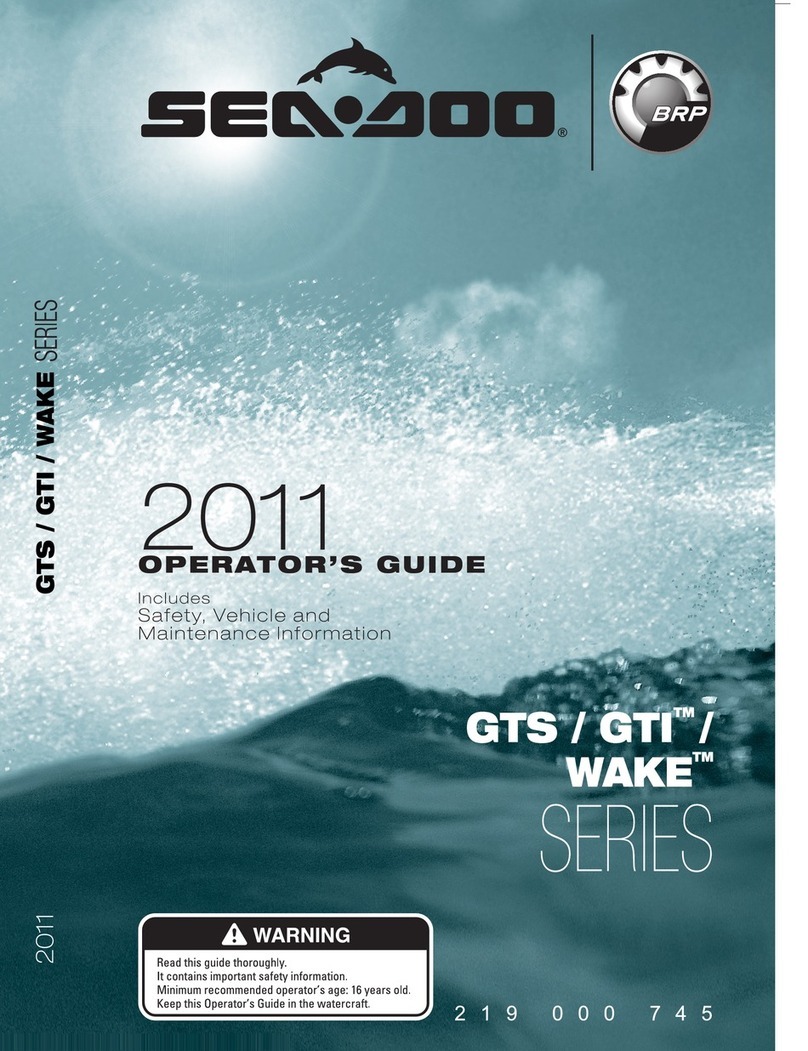
Sea-doo
Sea-doo GTS Series Manual
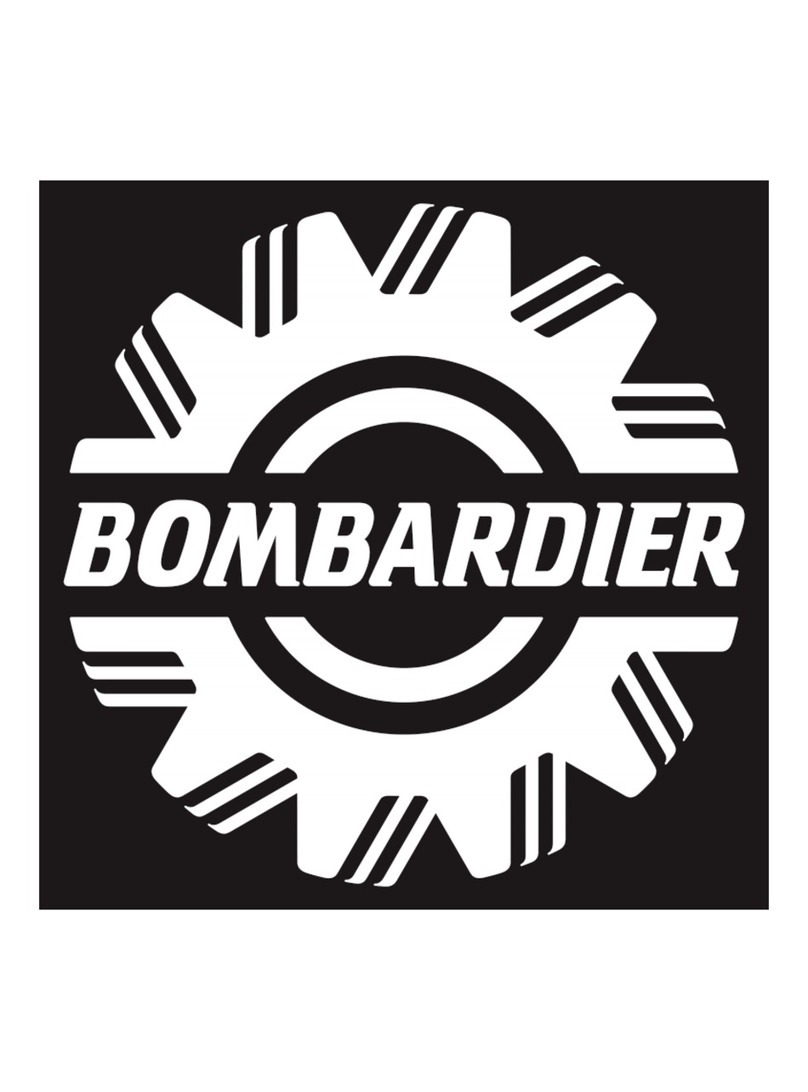
Sea-doo
Sea-doo Speedster 5894 Install guide
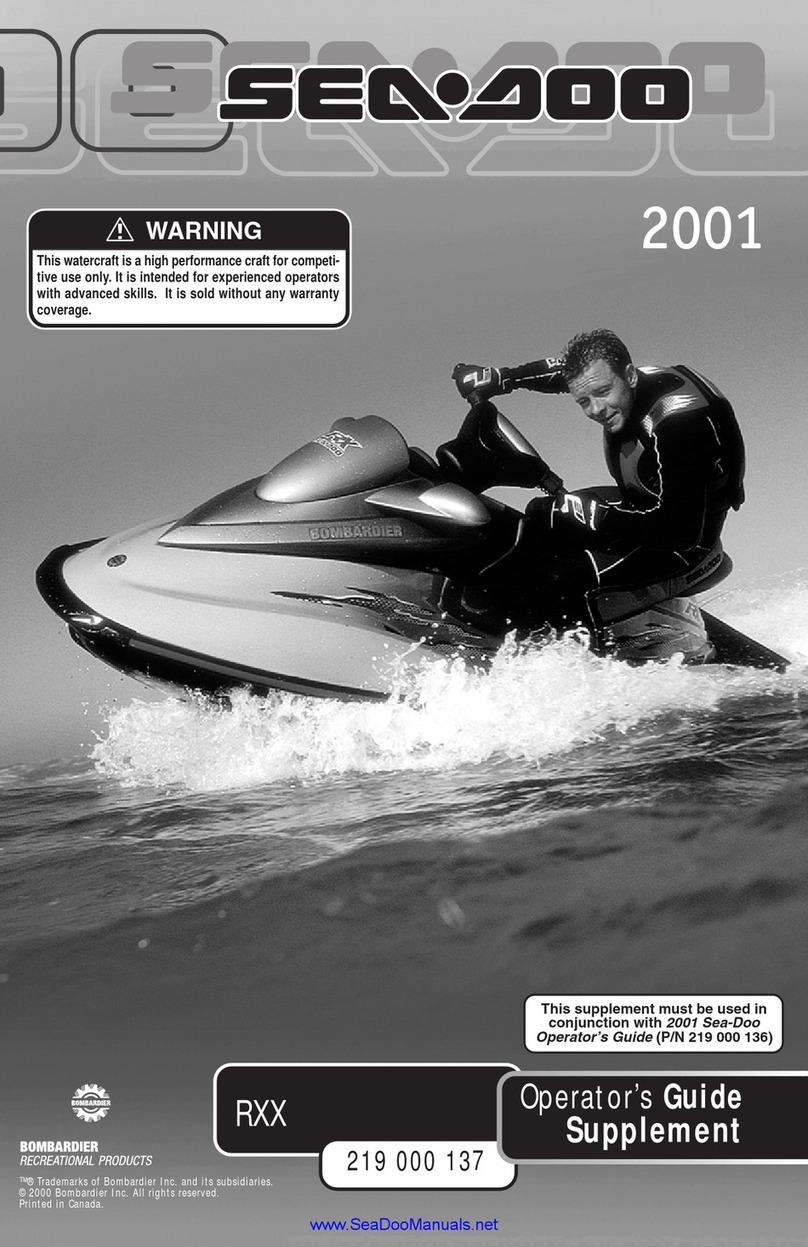
Sea-doo
Sea-doo 2011 RXX Manual
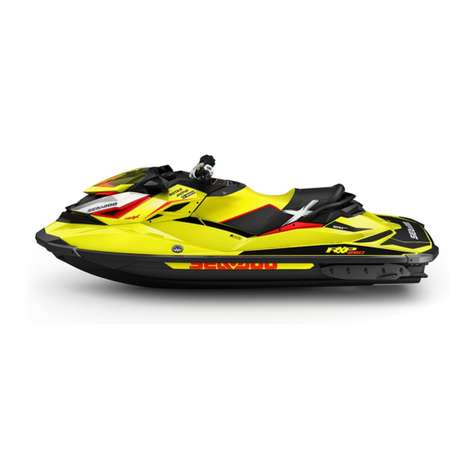
Sea-doo
Sea-doo RXP-X 260 Manual

Sea-doo
Sea-doo GS 5644 Manual
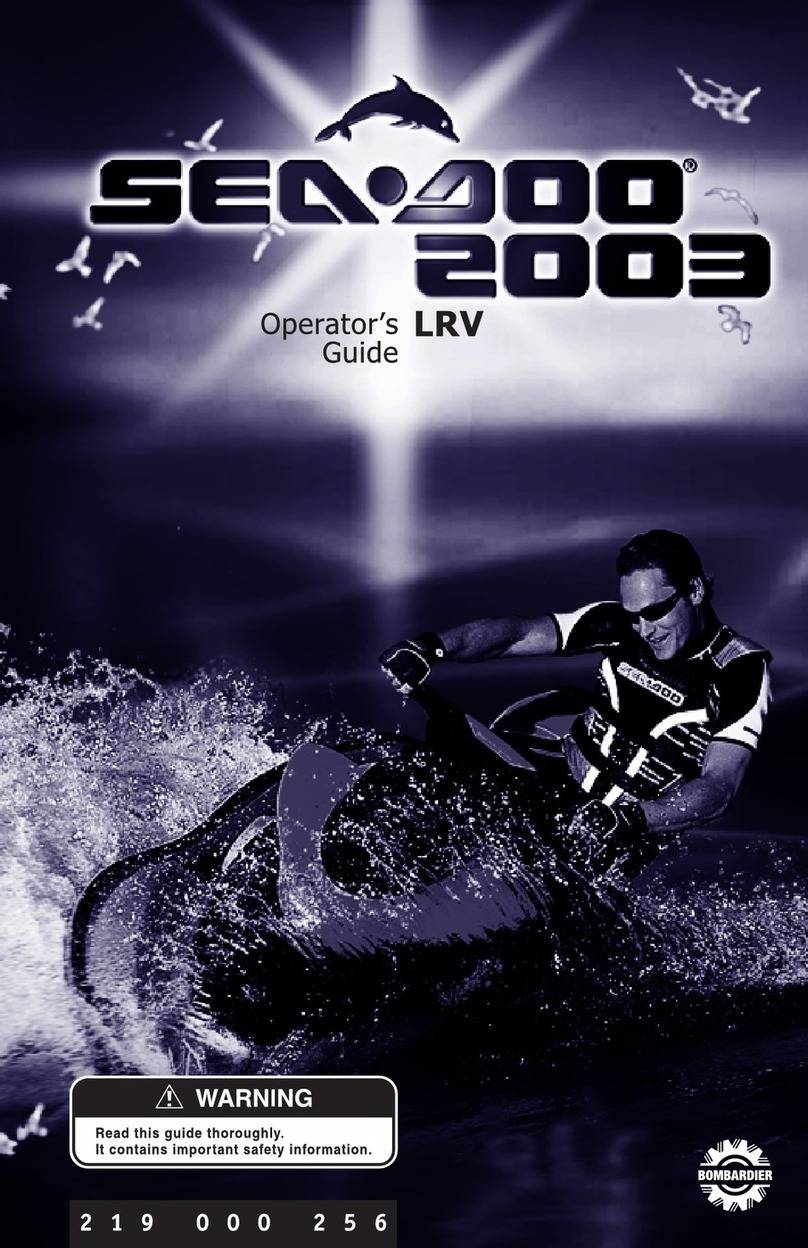
Sea-doo
Sea-doo 2003 LRV DI Manual
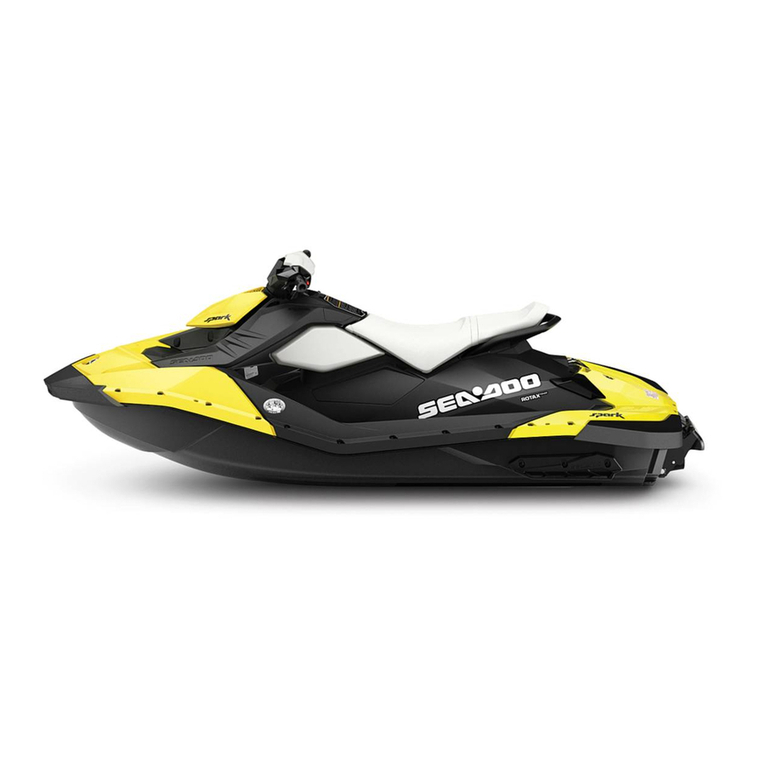
Sea-doo
Sea-doo SPARK Series Manual

Sea-doo
Sea-doo RXP-X 260 Manual
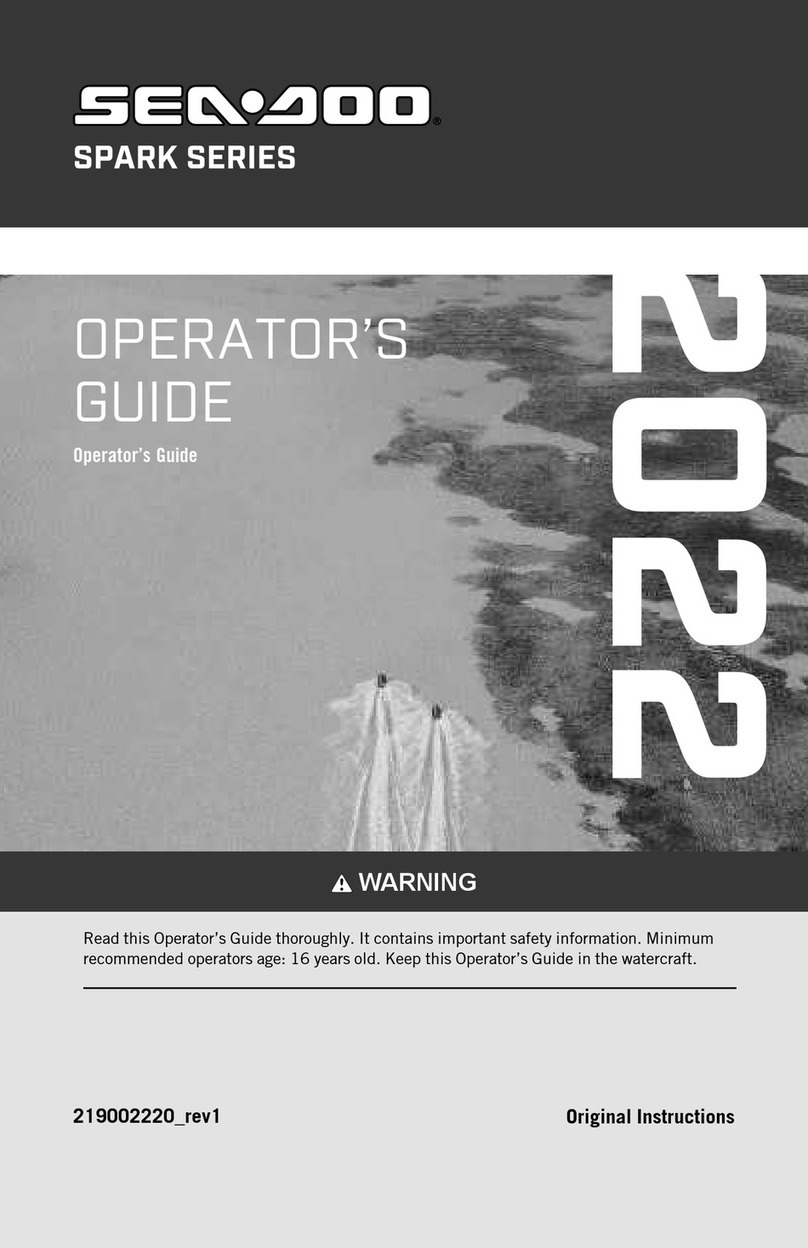
Sea-doo
Sea-doo SPARK 2022 Series Manual
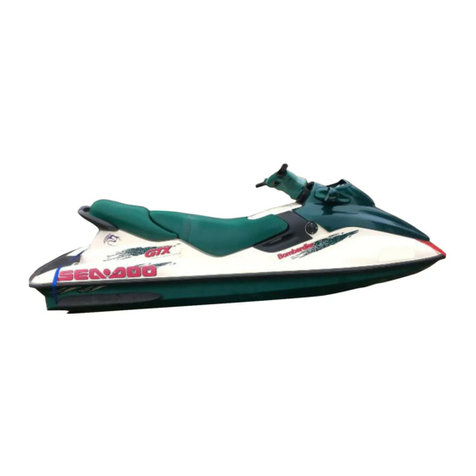
Sea-doo
Sea-doo GSX 5620 User manual

Sea-doo
Sea-doo GTS Series Manual

Sea-doo
Sea-doo SPORTSTER 4-TEC Install guide
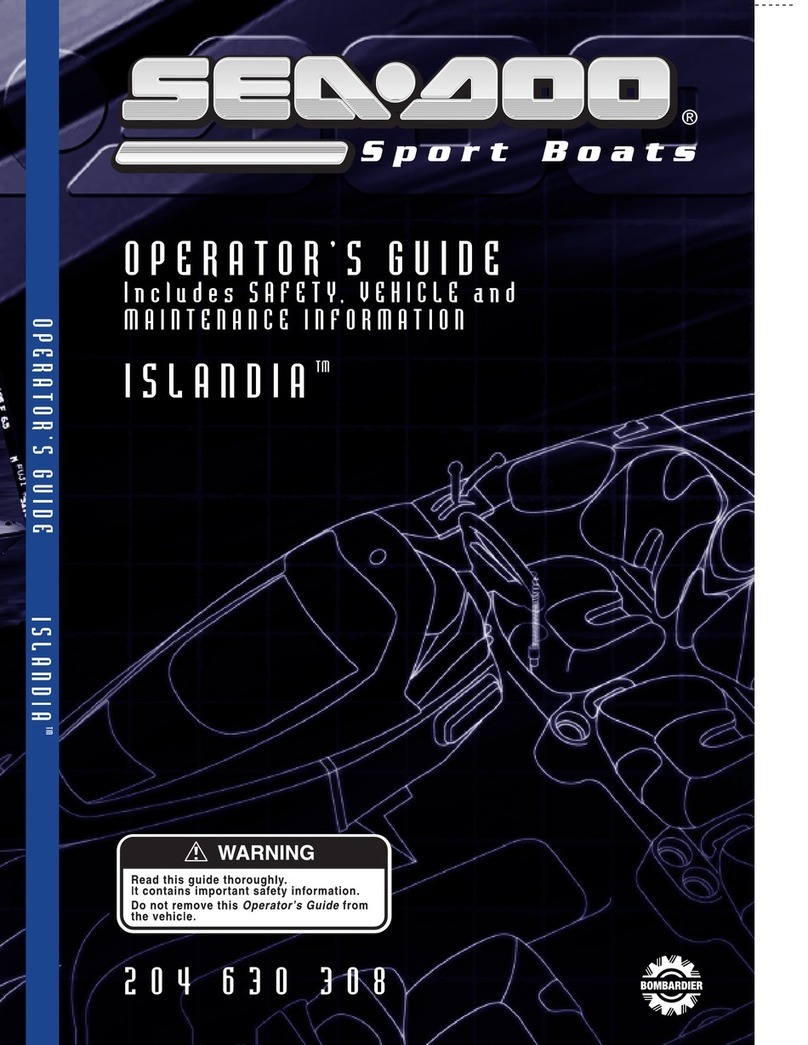
Sea-doo
Sea-doo ISLANDIA User manual
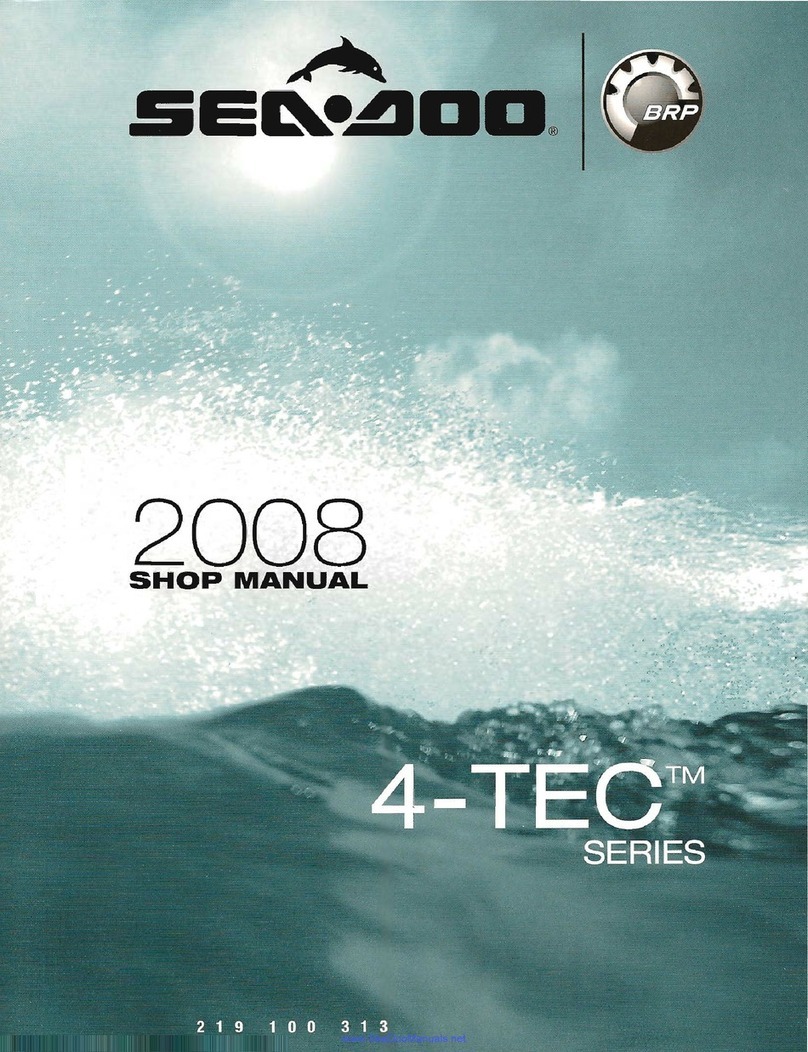
Sea-doo
Sea-doo 4-TEC series 2008 Install guide

Sea-doo
Sea-doo GSX Limited 5625 Manual
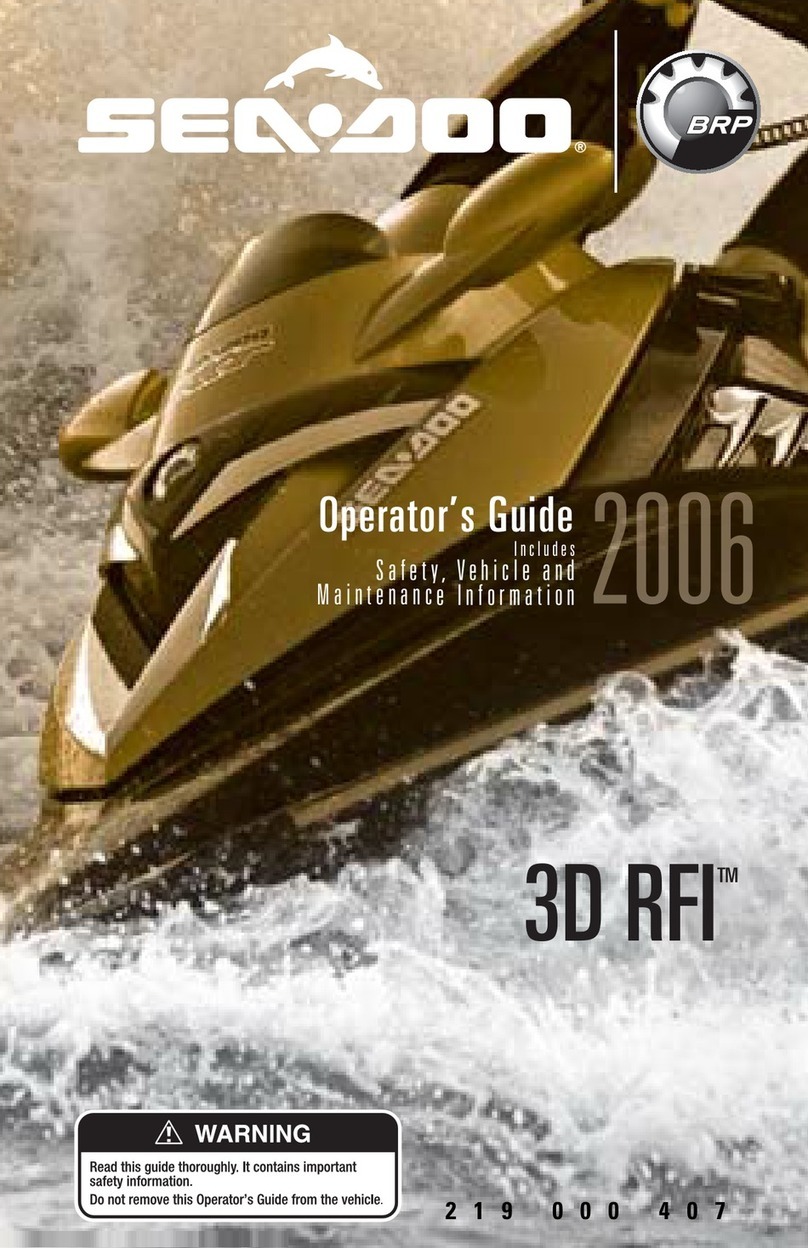
Sea-doo
Sea-doo 2006 3D RFI Manual
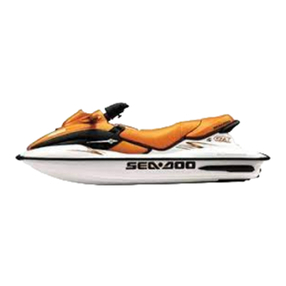
Sea-doo
Sea-doo 2001 GS Install guide
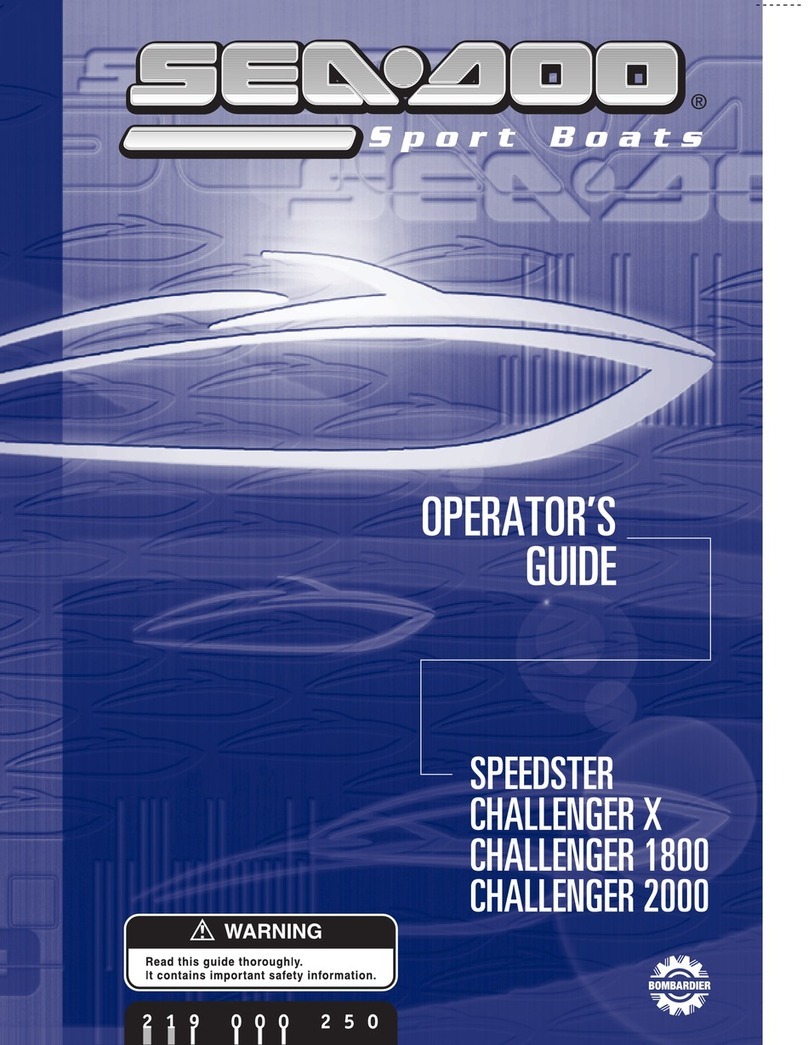
Sea-doo
Sea-doo Speedster Manual

Sea-doo
Sea-doo 2002 GTI Manual


